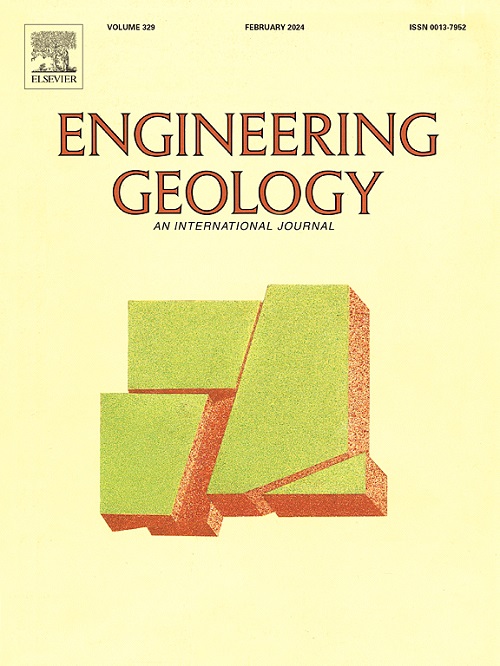An improved rock damage model from a cyclic temperature – triaxial loading experiment for compressed air energy storage caverns
IF 6.9
1区 工程技术
Q1 ENGINEERING, GEOLOGICAL
引用次数: 0
Abstract
While studies on rock damage have mostly examined cyclic mechanical loading, or addressed thermal and mechanical loadings separately, compressed air energy storage (CAES) projects require the coupling of both effects. Granite was used to demonstrate a systematic experimental procedure in which cyclic temperature effects was incorporated into fatigue damage study of rocks subject to cyclic mechanical loading. Granite specimens were pre-treated with cyclic temperatures up to 200 °C, 400 °C, and 600 °C, with the P-wave velocity tested after each cycle. Subsequently, the treated specimens went through triaxial cyclic loading. The upper limit of the triaxial cyclic loading was 200 MPa, and the confining pressures were 5 MPa, 10 MPa, and 15 MPa. Granite exhibited hardened and weakened behaviour. The specimens were weakened if the deviatoric stress exceeded the fatigue threshold, which was determined by the cyclic temperature and the confining pressure in this study. A damage model was derived to quantify the degree of hardening and weakening. The model improved the existing damage models by incorporating the cyclic temperature effect. This study lays a foundation for safe operation of CAES projects.
压缩空气储能洞穴循环温度-三轴加载实验的改进型岩石破坏模型
虽然对岩石损伤的研究主要是研究循环机械载荷,或者分别研究热载荷和机械载荷,但压缩空气储能(CAES)项目需要将这两种效应耦合起来。花岗岩被用来演示一个系统的实验程序,其中循环温度效应被纳入疲劳损伤研究的岩石受循环机械载荷。花岗岩试样分别在200°C、400°C和600°C的循环温度下进行预处理,并在每个循环后测试纵波速度。随后,对处理后的试件进行三轴循环加载。三轴循环加载上限为200 MPa,围压分别为5 MPa、10 MPa和15 MPa。花岗岩表现出硬化和弱化的行为。当偏离应力超过疲劳阈值时,试件会发生弱化,这是由循环温度和围压决定的。导出了一种损伤模型来量化硬化和弱化的程度。该模型通过纳入循环温度效应对现有损伤模型进行了改进。本研究为CAES工程的安全运行奠定了基础。
本文章由计算机程序翻译,如有差异,请以英文原文为准。
求助全文
约1分钟内获得全文
求助全文
来源期刊

Engineering Geology
地学-地球科学综合
CiteScore
13.70
自引率
12.20%
发文量
327
审稿时长
5.6 months
期刊介绍:
Engineering Geology, an international interdisciplinary journal, serves as a bridge between earth sciences and engineering, focusing on geological and geotechnical engineering. It welcomes studies with relevance to engineering, environmental concerns, and safety, catering to engineering geologists with backgrounds in geology or civil/mining engineering. Topics include applied geomorphology, structural geology, geophysics, geochemistry, environmental geology, hydrogeology, land use planning, natural hazards, remote sensing, soil and rock mechanics, and applied geotechnical engineering. The journal provides a platform for research at the intersection of geology and engineering disciplines.
 求助内容:
求助内容: 应助结果提醒方式:
应助结果提醒方式:


